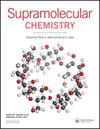小腔体的双结合模式
IF 2.6
4区 化学
Q3 CHEMISTRY, MULTIDISCIPLINARY
引用次数: 1
摘要
水的小尺寸和高凝聚力意味着水介导的相互作用强烈依赖于环境。因此,关于非极性溶质和离子如何与自身或彼此相互作用,还有很多东西需要学习。为了帮助解决这个问题,我们在这里报道了一个空腔和宿主,TMAX-Cl(2)。TMAX-Cl(2)具有两个不同的结合位点,一个结合疏水分子的浅非极性盘子,和一个结合阴离子的铵冠,TMAX-Cl(2)提供了对疏水和霍夫迈斯特效应的深入了解。我们发现与非极性位点的结合很弱,这表明需要更大的表面积才能进行实质性的结合。相比之下,尽管水的介电性很高,但与氨的结合力相对较强。这些发现提供了对水介导的相互作用的更好理解,并为我们继续研究这种宿主和相关的水溶性空腔体提供了定义TMAX-Cl 2的超分子性质。图形抽象本文章由计算机程序翻译,如有差异,请以英文原文为准。
Dual Binding Modes of a Small Cavitand
ABSTRACT The small size and high cohesiveness of water means that water-mediated interactions are strongly context dependent.As a result, there is still much to learn about how non-polar solutes and ions interact with themselves or each other.To help address this issue, we report here on a cavitand host, TMAX-Cl (2). Possessing two different binding sites, a shallow non-polar dish that binds hydrophobes, and a crown of ammoniums that bind anions, TMAX-Cl (2) provides insight into the hydrophobic and Hofmeister effects.We find that binding to the non-polar site is weak, suggesting that a larger surface area is needed for substantial binding.In contrast, binding to the crown of ammoniums is relatively strong, despite the high dielectric of water.These findings provide a better understanding of water-mediated interactions, and define the supramolecular properties of TMAX-Cl 2 as we continue our studies of this host and related water-soluble cavitands. Graphical Abstract
求助全文
通过发布文献求助,成功后即可免费获取论文全文。
去求助
来源期刊

Supramolecular Chemistry
化学-化学综合
CiteScore
3.60
自引率
3.00%
发文量
5
审稿时长
2.7 months
期刊介绍:
Supramolecular Chemistry welcomes manuscripts from the fields and sub-disciplines related to supramolecular chemistry and non-covalent interactions. From host-guest chemistry, self-assembly and systems chemistry, through materials chemistry and biochemical systems, we interpret supramolecular chemistry in the broadest possible sense. Interdisciplinary manuscripts are particularly encouraged. Manuscript types include: high priority communications; full papers; reviews, and; Methods papers, techniques tutorials highlighting procedures and technologies that are important to the field. We aim to publish papers in a timely fashion and as soon as a paper has been accepted and typeset it will be published in electronic form on the Latest articles section of the website. The two most important review criteria are that the paper presents high-quality work that fits generally into the broad spectrum of activities in the supramolecular chemistry field. Under normal circumstances, Supramolecular Chemistry does not consider manuscripts that would be more suitable in a highly specialized journal. This includes, but is not limited to, those based mostly or exclusively on topics such as solid state/X-ray structures, computational chemistry, or electrochemistry. .
The two most important review criteria are that the paper presents high-quality work that fits generally into the broad spectrum of activities in the supramolecular chemistry field.
 求助内容:
求助内容: 应助结果提醒方式:
应助结果提醒方式:


